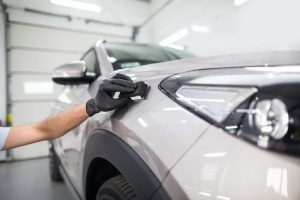When it comes to protecting your car’s paintwork, car owners often find themselves weighing two primary options: traditional car wax and the more modern ceramic coating. While both aim to keep your vehicle looking its best, they differ fundamentally in their composition, application, durability, and ultimately, the level of protection they offer. Understanding Car ceramic coating is key to making an informed decision for your car.
Car Wax: The Traditional Champion
Car wax has been the go-to choice for automotive enthusiasts for decades. It’s a sacrificial layer that sits on top of your car’s clear coat, providing a temporary barrier against contaminants and enhancing shine.
What it is:
- Natural Waxes: Primarily made from carnauba wax (derived from the Brazilian carnauba palm tree), often blended with other natural oils and solvents. Carnauba wax is prized for its deep, warm, and rich glow.
- Synthetic Waxes (Sealants): Often referred to as “paint sealants,” these are man-made polymers that offer similar protection to natural waxes but with slightly better durability and often a more reflective, glass-like shine. Modern “hybrid waxes” often combine natural waxes with synthetic polymers or even some SiO2 (ceramic) elements.
How it works: Wax creates a thin, slippery layer on the paint surface. This layer helps to repel water, make the paint look glossy, and provide a degree of protection against environmental elements.
Protection Offered by Wax:
- UV Ray Protection: Wax offers some protection against harmful UV rays, helping to prevent paint oxidation and fading.
- Minor Contaminant Resistance: It creates a barrier against light dirt, dust, and some environmental fallout, making the car slightly easier to clean.
- Water Beading: Wax is highly effective at causing water to bead up on the surface, which is visually appealing and helps water roll off.
- Enhanced Shine: Provides a warm, deep gloss that many traditionalists love.
Drawbacks of Wax Protection:
- Short Durability: This is wax’s biggest limitation. Traditional waxes typically last only a few weeks to 2-3 months under normal driving conditions and regular washing. Synthetic waxes or hybrid spray waxes might extend this to 4-6 months, or even up to a year for advanced formulations, but rarely longer.
- Limited Chemical Resistance: Waxes offer limited resistance to harsh chemicals like strong detergents, acid rain, bird droppings, or industrial fallout. These contaminants can quickly break down the wax layer and begin to etch into the paint.
- No Scratch/Chip Protection: Wax provides virtually no protection against scratches, swirl marks (beyond the mildest kind from very careful washing), or rock chips.
- Frequent Reapplication: To maintain continuous protection, wax needs to be reapplied frequently, making it a more labor-intensive solution over time.
Ceramic Coating: The Modern Innovator
Ceramic coating is a more advanced, semi-permanent protective layer that bonds chemically with your car’s factory paint.
What it is: A liquid polymer, primarily composed of silicon dioxide (SiO2) and often other elements like titanium dioxide. When applied and cured, it forms a hard, transparent, glass-like shell.
How it works: Unlike wax, which sits on top, ceramic coating becomes an integral part of your car’s clear coat. It fills in the microscopic pores of the paint, creating an incredibly smooth, slick, and extremely durable surface.
Protection Offered by Ceramic Coating:
- Superior UV Ray Protection: Forms a much stronger and longer-lasting barrier against UV rays, significantly reducing paint oxidation and fading.
- Excellent Chemical Resistance: The chemical bond makes it highly resistant to corrosive elements like acid rain, bird droppings, tree sap, and industrial fallout. These contaminants struggle to adhere and etch into the surface, making them easier to wash off.
- Hydrophobic Properties: Exhibits extreme hydrophobicity, causing water to bead and sheet off the surface very efficiently, taking dirt and grime with it. This creates a “self-cleaning” effect.
- Enhanced Minor Scratch & Swirl Resistance: While not “scratch-proof,” the added hardness of the ceramic layer makes the paint significantly more resistant to minor swirl marks often caused by improper washing techniques. It provides a noticeable improvement in resilience against light abrasions.
- Long-Lasting Durability: This is its main selling point. Professional ceramic coatings can last 2 to 5 years or more with proper maintenance, vastly outperforming waxes. Even quality DIY kits typically last 6 months to 2 years.
- Enhanced Gloss and Clarity: Ceramic coatings provide a deep, reflective, and often “mirror-like” finish that enhances the clarity and depth of your car’s paint color.
Drawbacks of Ceramic Coating Protection:
- High Initial Cost: The upfront investment is significantly higher than wax, especially for professional application due to the extensive paint preparation required.
- Requires Meticulous Prep Work: For optimal bonding and performance, the paint must be flawlessly clean and decontaminated, often requiring paint correction (polishing) to remove imperfections before application. This is a critical step.
- Not Indestructible: It does not protect against deep scratches, rock chips, or major impacts. It’s a highly durable protective layer, not an impenetrable shield.
- Requires Specific Maintenance: While easier to clean, ceramic coatings still require regular washing with pH-neutral shampoos and proper drying to prevent water spots and maintain their performance. Harsh chemicals or automatic brush washes can degrade the coating.
Which Offers Better Protection?
Ceramic coating unequivocally offers superior and longer-lasting protection compared to traditional car wax.
Here’s a direct comparison of key protective aspects:
Conclusion:
If you’re seeking a quick, affordable shine and don’t mind frequent reapplication, car wax remains a viable option. However, for those who desire long-term, robust protection against environmental damage, significantly easier cleaning, and an enhanced, enduring gloss, ceramic coating is the clear winner. It’s an investment that pays off in reduced maintenance effort, superior protection, and the preservation of your vehicle’s aesthetic and resale value over many years.







